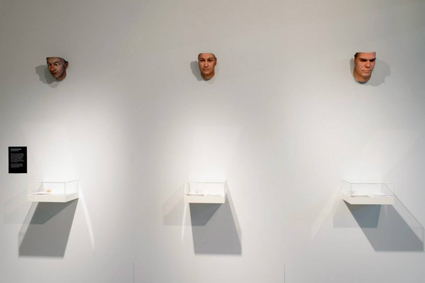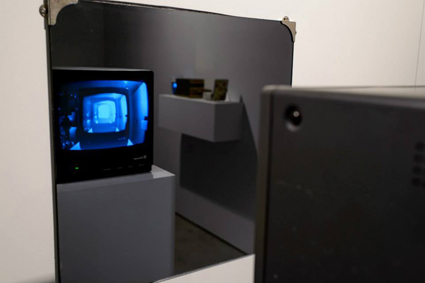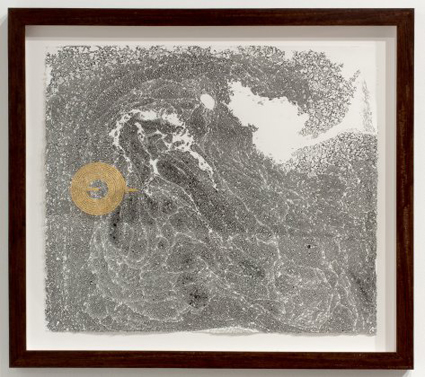Forces resisted & revealed
Gail Priest: Trace Recordings, UTS Gallery; Joyce Hinterding, Breenspace

Heather Dewey-Hagborg’s Stranger Visions (2012)
photo David Lawrey, courtesy the artist
Heather Dewey-Hagborg’s Stranger Visions (2012)
It is now possible to know almost everything about our existence via information gleaned from the objects we’ve touched, websites visited and purchases we’ve made. Our presence is constantly being recorded via a network of private and governmental security cameras and we aid this digital monitoring by using GPS-equipped devices and posting social media updates. Given the implications of these aspects of contemporary living it’s utterly amazing that we don’t throw our devices off the nearest bridge and lock ourselves away in a padded Faraday Cage.
But we don’t. Rather we tend to compartmentalise (Facebook good, video surveillance—ah, whatever) and keep functioning regardless of the digital panopticon. Trace Recordings, curated by Chris Gaul and Holly Williams at UTS Gallery, highlights these invasive forces but tempers the potential for panic attacks by providing playful methods of subversion.
The work that clearly encapsulates the extent to which our identities are exposed is US-based artist Heather Dewey-Hagborg’s Stranger Visions (2012). From discarded chewing gum, cigarette butts and stray strands of hair, Dewey-Hagborg extracts DNA samples creating a possible genetic profile. With this information she generates a 3D print of the litterer’s face. The masks hover on the wall above snapshots of the samples and their locations. These disembodied people are strangely familiar yet not quite specific enough to be anyone in particular, the ambivalence almost triggering a slide into that old ‘uncanny valley.’ Small cards provide genetic information—racial type, gender, eye-colour, nose size. Dewey-Hagborg also includes a potted history of the ancestry type—when a racial strand emerged from chaos and the potential genetic health issues it might face. These accompanying facts offer an interesting sense of the big picture—the hand of fate adding an even greater sense of vulnerability to these ‘strangers.’
The curators are particularly interested in how contemporary surveillance techniques relate to portraiture and have included two other works focusing on the face. Memory (2013) by Shinseungback Kimyonghun (Korea) is a framed digital tablet which uses facial recognition software to record the visage of everyone who stares at it. These faces are then combined over time to create a universal human. Subtle for an interactive piece (you just have to trust your face is in there melding with thousands of others), the tastefully misty portrait is an everyman/woman also with a hint of that uncanny slippery slope.
New York-based artist Adam Harvey’s CV Dazzle (2013) aims for anonymity through hyper-individuality. Harvey offers workshops in face painting designed to confuse facial recognition programs. By creating unexpected and idiosyncratic geometric patterns on key points of your face, the software is supposedly unable to get a fix. Harvey proposes that by making yourself more obvious in the analogue world you might be able to avoid detection in the digital.

Denis Beaubois, installation view
photo David Lawrey, courtesy the artist
Denis Beaubois, installation view
Two other pieces were impressive for their conceptual poetry. Denis Beaubois showed two works from 2000 in which surveillance technology is configured, using mirrors, so that it is forced to interrogate its own image. It’s a closed-loop of paranoia or narcissism or maybe both. Matt Richardson’s Descriptive Camera (2012) captures an image and sends it off to the internet ether where anonymous human subjects write text descriptions of the scene. These are sent back to the device which prints the information on a hacked receipt printer. In such a visually focused reality this anti-pictorial outcome and the complex mix of digital and analogue (human) processing is as amusing as it is poignant.
Trace Recordings is an exhibition of significant scale featuring 10 artists who tease out multiple complexities of the state of surveillance. However, rather than leaving feeling twitchy, I was excited about the intelligence of these artworks and the future subversions that will arise in resistance. Or maybe I’m not so worried because I’ve just pre-ordered my Philip K Dick Scramble Suit on eBay.

Joyce Hinterding, ‘The Diffusion Reactors 1’, 2013
courtesy the artist and Breenspace
Joyce Hinterding, ‘The Diffusion Reactors 1’, 2013
Joyce Hinterding, Simple Forces
While Trace Recordings worries at the all-permeating forces of technological surveillance, Joyce Hinterding revels in the equally ubiquitous, yet natural force of electromagnetic energy. In her exhibition at Breenspace she presented elegant, large-scale spiral diagrams made from ink and conductive graphite. When amplified by small tabs of circuitry they can channel the hum of the Earth.
Several of these works are displayed as ‘unplugged’ wall pieces (the Arts Santa Monica, 2011 and Heide Museum, 2010 series) accompanied by two large table-top designs, SoundWave: Induction drawings 1 & 2 (2012), that are sonically active. By tracing the designs with your hand, or even just hovering above the surface, your body and the force become connected and the ever-present deep hum shifts pitch, buzzes, spits and crackles. It’s a completely meditative work, playable like an instrument, encouraging a kind of Tai Chi dance of the fingers.
Contrasting with the bold graphite spirals are five other works on paper, The Diffusion Reactors series (2013), using an electrostatic carbon and oil mix to create delicate organic swirls and constellations. These are mute but audio potential is implied by the circuitry, inviting you to imagine the magical sound of these alluring landscapes.
After experiencing Hinterding’s beautifully crafted audio paintings I’ve decided to hold off on the Faraday Cage for a while so I can enjoy the Earth’s electromagnetic song a little longer.
Trace Recordings, UTS Gallery, 22-Oct-29 Nov, 2013, www.tracerecordings.net; Joyce Hinterding, Simple Forces, BreenSpace, 25 Oct-23 Nov, 2013; www.breenspace.com/. (Sadly Breenspace has now closed.)
RealTime issue #119 Feb-March 2014 pg. 20






